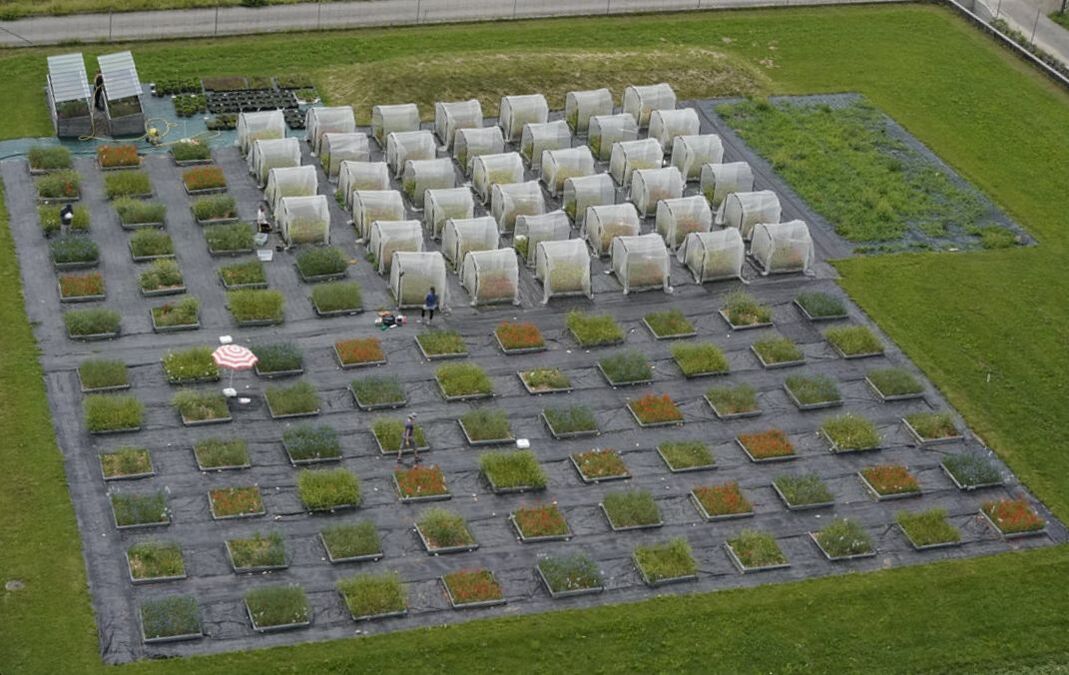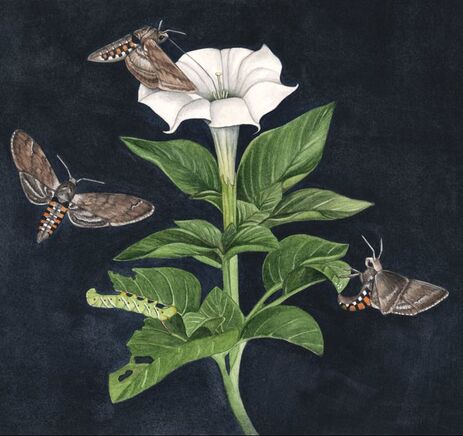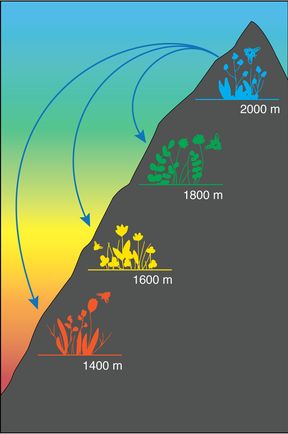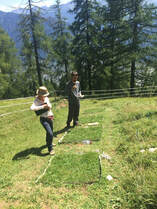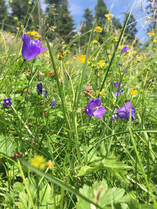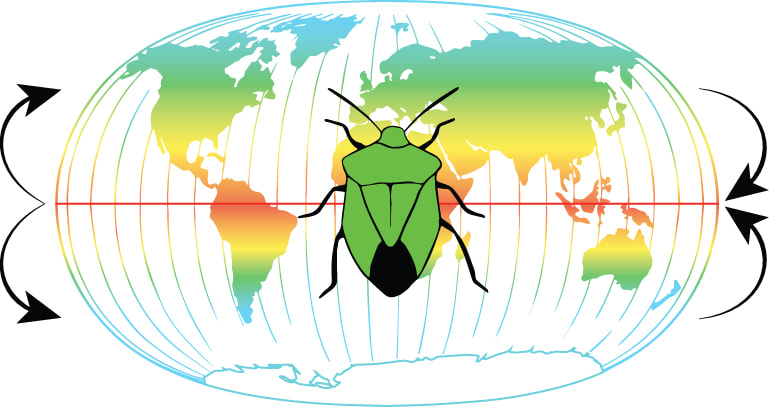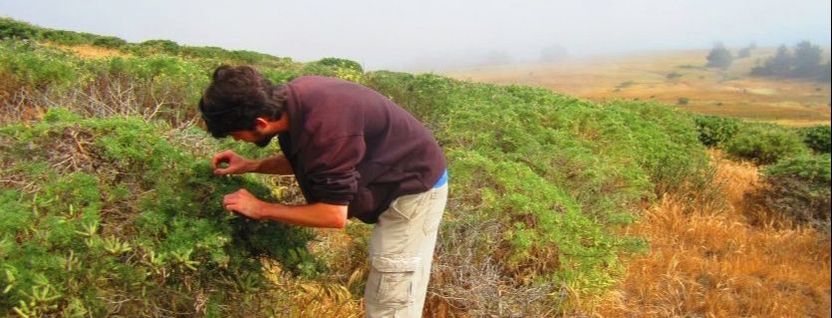Research
My research focuses on three interconnected themes: (1) how mutualisms affect species coexistence, (2) the eco-evolutionary dynamics of mutualism, and (3) climate change impacts on plants and insects.
3. How mutualisms affect species coexistence
Coexistence theory of mutualismMost plant-pollinator communities are extremely diverse. For this diversity to be maintained, however, species must coexist in the face of competitive exclusion. Classical theories in ecology, such as R* theory or modern coexistence theory, predict coexistence in consumer-resource interactions. Yet, we lack comparable theories for mutualism, leaving the mechanisms maintaining diversity unresolved for some of the most wide-spread and ecologically important interactions on Earth. I have developed theory which applies the classical competitive exclusion principle to mutualisms, showing that just as species cannot coexist on the same limiting resources, mutualists cannot coexist when they are most limited by the same mutualistic partners (Johnson & Bronstein 2019, Ecology). Coexistence requires that species partition their mutualistic partners and other limiting resources. More recently, I have developed a coexistence theory of mutualism that predicts how mutualisms and resources jointly affect species coexistence; for example, how pollinators affect plant coexistence (Johnson 2021, Ecology). My theory predicts when mutualisms promote coexistence, and when they drive competitive exclusion.
Pollinator effects of plant coexistence
Mounting concerns about the effects of climate change and pollinator decline have fueled calls to study the roll of pollinators in maintaining plant diversity. It has been hypothesized that pollinators favor plant coexistence by providing opportunities for niche partitioning, which stabilizes competition because plant species become most limited by different sets of pollinators. Other theory, however, predict the opposite: that pollinators destabilize competition by favoring common plants over more rare species. With Jonathan Levine (ETH Zürich, Princeton), I studied how pollinators influence plant coexistence and simulated pollinator decline (Johnson et al. 2022, Nature). I subjected annual plant species growing across experimental gradients in competitor density in a field study mimicking a patchy meadow to either ambient pollinators or pollen addition to alleviate competition for pollinators. We found that competition for pollinators destabilized plant competition and significantly reduced plant coexistence, mainly because large floral displays increased conspecific pollination, alleviating intraspecific competition. By experimentally simulating pollinator decline, we found that while pollinator decline drastically reduced floral visitation and plant per capita population growth rate, it did so disproportionately for different plant species. Furthermore, the decline in plant population growth rates was well predicted by the reduction in floral visitation with pollinator decline. This suggests that pollinator decline may erode plant diversity by reshuffling plant competitive hierarchies and driving competitive exclusion. Unraveling how mutualisms affect coexistence is critical to predicting how climate change may alter plant-pollinator communities as some species go extinct and others invade.
|
2. Eco-evolutionary dynamics of mutualism
|
Mutualisms are critical for the maintenance of biodiversity; yet, their evolutionary origins remain enigmatic. Intriguingly, evidence shows that many mutualisms actually evolved from antagonistic interactions. I advanced a new hypothesis for the evolution of mutualism: the Co-Opted Antagonist Hypothesis, in which species evolve to “co-opt” an antagonist to perform a beneficial function, which changes the ecology of the interaction and favors coevolution of traits that drive the interaction to net mutualism. (Johnson et al., 2021: Nature Communications). For example, some plants and insects may have transitioned from herbivory to pollination as plants evolved to co-opt insect search behaviors for larval host plants to disperse their pollen. With Judith Bronstein and Régis Ferrière (University of Arizona), I evaluated our hypothesis by developing an eco-coevolutionary model of a community in which a hawkmoth pollinates some of its larval host plants. The model was fully parameterized with ecological data, including data that a graduate student and I collected on the insect’s foraging behavior and host plant preferences (Smith et al. 2018, Ecological Entomology). Our model predicts the coevolution of mutualism despite increased plant interactions with a voracious herbivore, with model trait values that are statistically indistinguishable from empirical estimates. More broadly, our theory explains how mutualism can evolve for some of the most conspicuous partnerships on Earth and reconciles several challenges concerning mutualism evolution, such as how mutualisms evolve without very tight partner fidelity and how ecological context influences evolution, and vice-versa.
|
3. Climate change impacts on plants and insects
Climate-driven mismatches between plants and pollinators
|
Pollinators are critical for maintaining Earth’s biodiversity and ensuring global food security, but many pollinators are now threatened by climate change among other factors. Which species are vulnerable to extinction under future climate change? In fact, many plants are flowering earlier in the year due to climate change, which may force them to interact with novel pollinator species. What are the consequences of novel interactions forged under climate change? At the ETH Zürich, we experimentally simulated climate change by transplanting an alpine community downslope, thereby exposing plants to the climates and novel plant and pollinator communities that they may face with climate change. We found that climate warming re-wired plant-pollinator interactions with significant impacts on plant reproductive fitness (Richman et al. 2020, Global Change Biology). I am interested in how climate change affects plant and pollinator phenology (seasonal timing) and its consequences for plant-pollinator coexistence.
|
|
Temperature effects on insect dynamics and evolution
I integrate theory and data to understand climate impacts on insects. With Priyanga Amarasekare (UCLA), I quantified temperature effects on the life history traits of the bordered plant bug, Largus californicus, to parameterize a mechanistic population model, which I validated by conducting censuses and using historical field data to bracket 25 years of climate change (Johnson et al. 2016, Functional Ecology). Our study was highlighted as a “template for future studies of insect populations, both under current conditions and in the context of global change” (Bewick 2016). I am using theory and data to study insect evolutionary responses to climate change (Amarasekare & Johnson 2017, American Naturalist) as well as oscillatory population dynamics that can predispose species to extinction (Johnson & Amarasekare 2015, American Naturalist).
Another ongoing project in collaboration with Lauren Buckley (University of Washington) leverages data science approaches to integrate insect physiology, CMIP6 climate model projections, and mechanistic models to forecast insect fitness and population dynamics with climate change around the world (Johnson et al. submitted: American Naturalist). I plan to use models and data to provide global forecasts of invasive insects, pest outbreaks, and pollinator declines, as well as evaluate mitigation strategies such as biocontrol or assisted pollinator migration. Ecological forecasting offers a promising approach to anticipating climate impacts on biological communities, but these tools are far less developed in ecology than in other fields. Developing quantitative tools for studying climate change impacts on insects is critical for predicting the ecological consequences of climate change. |


